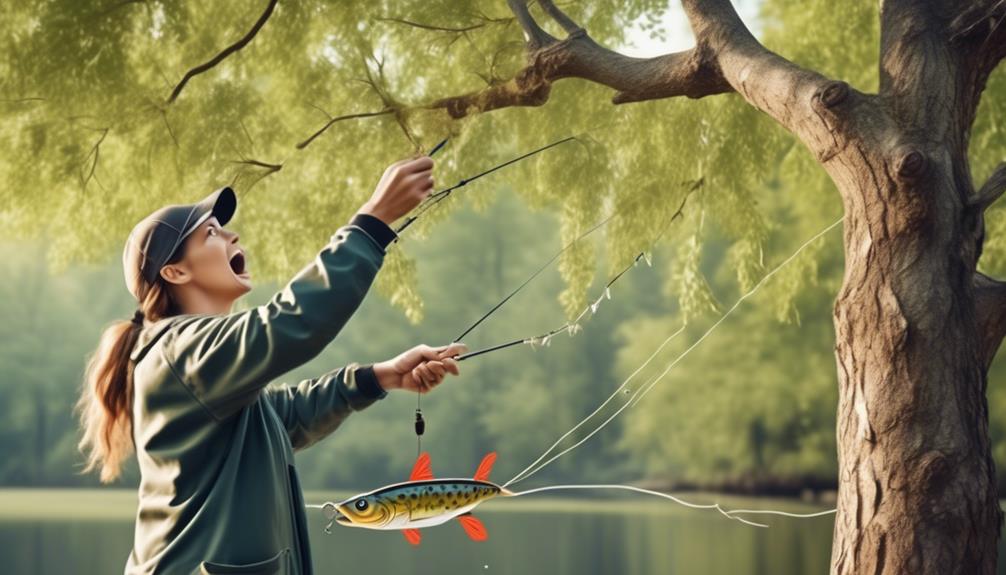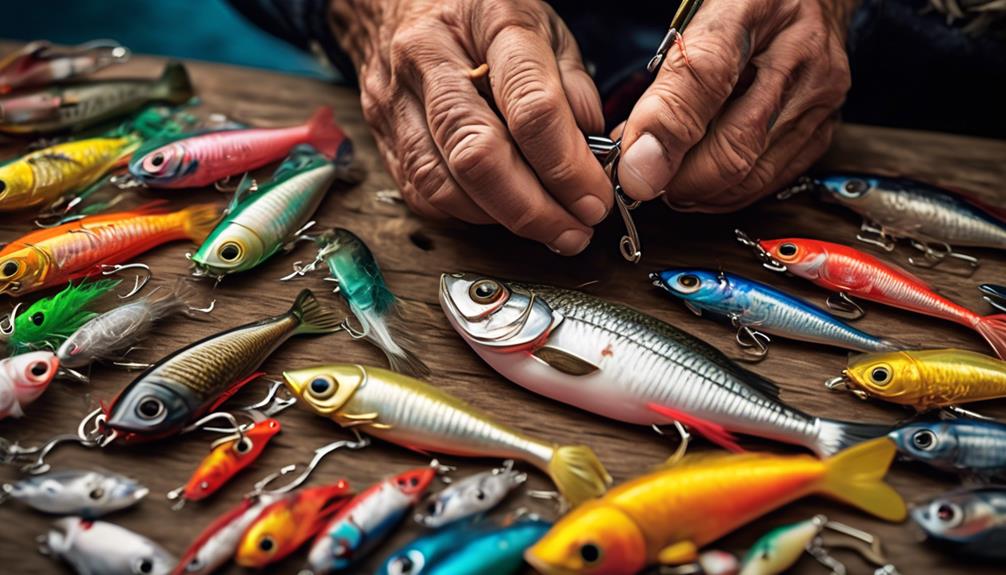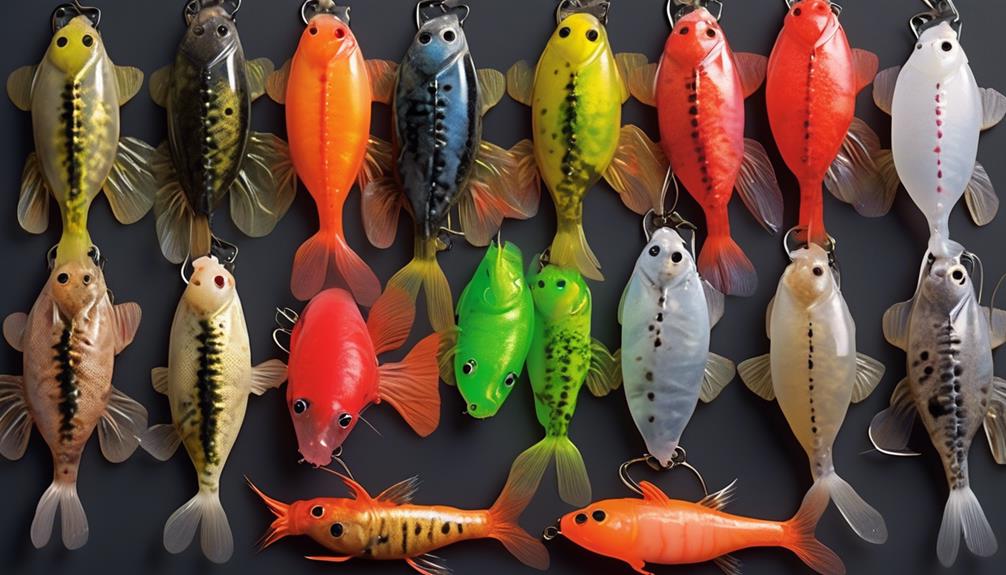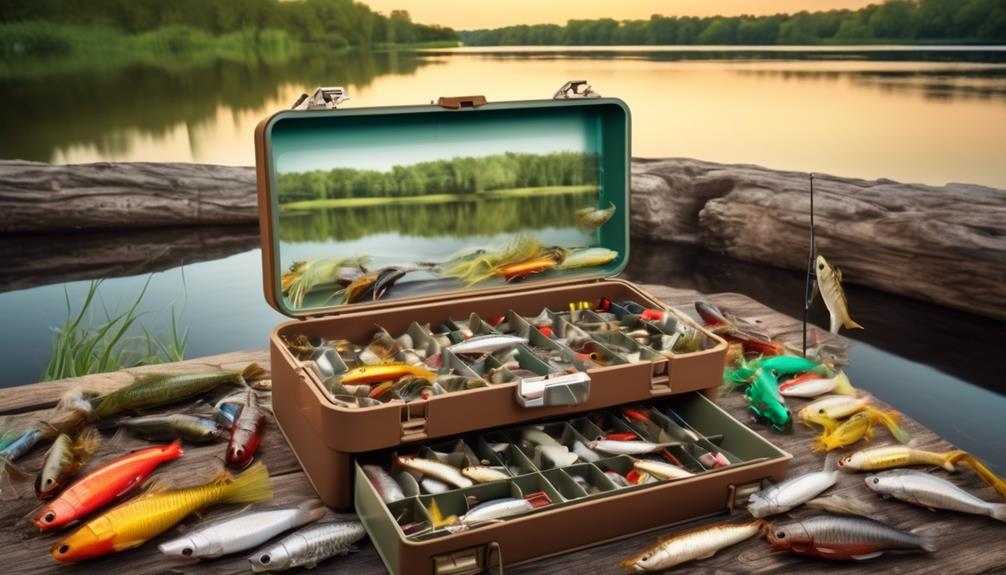You may not be aware that even the most experienced anglers can fall into the trap of these common lure usage mistakes while fishing.
From choosing the wrong color to neglecting water clarity, there are several factors that can significantly impact your success on the water.
By avoiding these errors, you can greatly increase your chances of landing that prized catch.
Choosing the Wrong Color
When selecting lure colors for fishing, it's important to consider the natural surroundings and the behavior of the fish you're targeting. One crucial factor to keep in mind is light reflection. Different colors reflect light differently, and this can affect how fish perceive your lure.
For example, lighter colors like white or chartreuse tend to reflect more light, making them more visible in murky waters or low-light conditions. On the other hand, darker colors like black or dark blue absorb more light, making them ideal for clear water or bright, sunny days.
Understanding fish vision is also essential when choosing lure colors. Fish have different visual capabilities depending on their species and the environment they inhabit. For instance, bass and trout have excellent color vision and can distinguish between various hues. In contrast, species like catfish have poor color vision but are sensitive to contrasts and movement.
Therefore, selecting colors that stand out in the water and trigger a fish's predatory instincts is crucial for a successful catch.
Using the Wrong Size
Selecting the appropriate lure size is crucial for enticing fish and improving your chances of a successful catch. Using the wrong size can result in missed opportunities and frustration. To ensure you're using the right size lure, consider the following:
- Selecting proper bait: Different fish species have varying preferences when it comes to lure size. Larger fish may be attracted to bigger lures, while smaller ones might prefer smaller offerings. Research the specific species you're targeting to understand their preferred bait size. Additionally, take into account the natural prey available in the fishing area and try to match the size of your lure to mimic it.
- Understanding fish behavior: Fish behavior can be influenced by a variety of factors, including water temperature, time of day, and feeding habits. During certain times, fish may be more active and willing to strike at larger lures, while at other times, they may be more cautious and inclined to go for smaller bait. By observing and understanding fish behavior, you can adjust the size of your lure accordingly to increase your chances of a successful catch.
- Experimenting and adapting: Don't be afraid to experiment with different lure sizes. If you're not having luck with a certain size, try switching to a smaller or larger option to see if it makes a difference. Adapt to the conditions and the fish's response, as this can vary based on the location and environmental factors.
Incorrect Retrieval Techniques
To maximize your chances of a successful catch, it's essential to master the correct retrieval techniques when using fishing lures.
One common mistake anglers make is improper rod positioning. When retrieving a lure, it's important to keep your rod at the correct angle. If you hold the rod too high, it can create a steep angle with the water, causing the lure to rise too quickly and appear unnatural to the fish. On the other hand, if the rod is too low, the lure may drag along the bottom or get caught in debris. The ideal position is to keep your rod at a medium level, allowing for a natural and enticing movement of the lure through the water.
Another crucial aspect of retrieval techniques is speed adjustment. Many anglers make the mistake of using a constant retrieval speed throughout. However, fish often respond better to varied retrieval speeds. When using techniques like twitching or jerking, it's essential to vary the speed to mimic the erratic movements of prey. Additionally, adjusting the speed can help you determine the most effective pace for attracting fish. By experimenting with different speeds, you can find the optimal tempo that entices fish to strike.
Mastering rod positioning and speed adjustment are fundamental to successful lure retrieval. By paying attention to these details and making adjustments as needed, you can significantly improve your chances of a rewarding catch.
Ignoring Weather Conditions
In fishing, overlooking weather conditions can significantly impact your lure's effectiveness and ultimately, your chances of a successful catch. Weather plays a crucial role in determining fish behavior and their feeding patterns. Ignoring weather conditions can lead to using the wrong bait and presenting it in an ineffective manner.
To avoid this, consider the following:
- Proper bait selection: Different weather conditions require different types of bait. For example, during overcast days, fish tend to stay closer to the surface, making topwater lures and bright-colored baits more effective. On the other hand, during sunny days, fish may seek shelter in deeper waters, requiring the use of diving lures or live bait. Ignoring these factors can result in using the wrong bait and diminishing your chances of a successful catch.
- Understanding fish behavior: Weather conditions such as changes in barometric pressure and wind direction can influence fish behavior. For instance, before a storm, fish are more likely to feed actively as they anticipate the approaching weather change. Understanding these patterns and adjusting your fishing techniques accordingly is essential for a successful day on the water.
- Adapting presentation: Weather conditions can affect water clarity and temperature, which directly impacts how fish perceive and react to your lure. Adjusting your retrieval speed, depth, and presentation style to match the prevailing weather conditions can greatly improve your chances of enticing a strike.
Neglecting to Match the Hatch
Considering the impact of weather conditions on fish behavior, neglecting to match the hatch can significantly reduce your chances of a successful catch. Inadequate research and lack of observation are common reasons for this mistake.
Matching the hatch means using lures that closely resemble the insects or baitfish that are currently hatching and present in the water. This is crucial because fish are more likely to strike at something that closely resembles their natural prey at a given time.
Inadequate research is a major pitfall. Fishermen often fail to gather information about the specific insects or baitfish that are prevalent in the area they plan to fish. Without this knowledge, they may use the wrong lures, missing out on potential bites.
Lack of observation exacerbates the issue. Even with prior research, if you don't take the time to observe the water and the behavior of fish, you mightn't realize that the fish are actively feeding on a particular type of insect or baitfish. This can result in using lures that the fish aren't interested in, leading to a frustrating and unproductive fishing trip.
To avoid this mistake, always strive to research the local insect and baitfish populations before heading out to fish. Additionally, closely observe the water and the fish to determine what they're feeding on at that moment. Matching the hatch is a crucial aspect of successful fishing, and neglecting it can greatly diminish your chances of making a good catch.
Overlooking Line and Leader Selection
You might be underestimating the importance of selecting the right line and leader for your fishing needs. The type of line and leader you use can significantly impact your fishing success.
Here are a few key considerations you should keep in mind:
- Knot tying: Properly tying knots is crucial when selecting lines and leaders. Different types of lines and leaders require different knots for optimal strength and performance. Take the time to learn and practice the appropriate knots for the specific lines and leaders you're using. A poorly tied knot can lead to lost fish and frustration.
- Tackle maintenance: Regularly inspecting and maintaining your fishing tackle, including your line and leader, is essential. Check for any signs of wear, such as fraying or damage, and replace them as needed. Overlooking the condition of your line and leader can result in break-offs and missed opportunities.
- Matching line and leader to the target species: Consider the species of fish you're targeting when selecting your line and leader. Different fish have different behaviors and habitats, which may require specific types of lines and leaders. For example, when targeting fish in heavy cover, a strong and abrasion-resistant line and leader may be necessary to prevent break-offs.
Using Improper Hooks
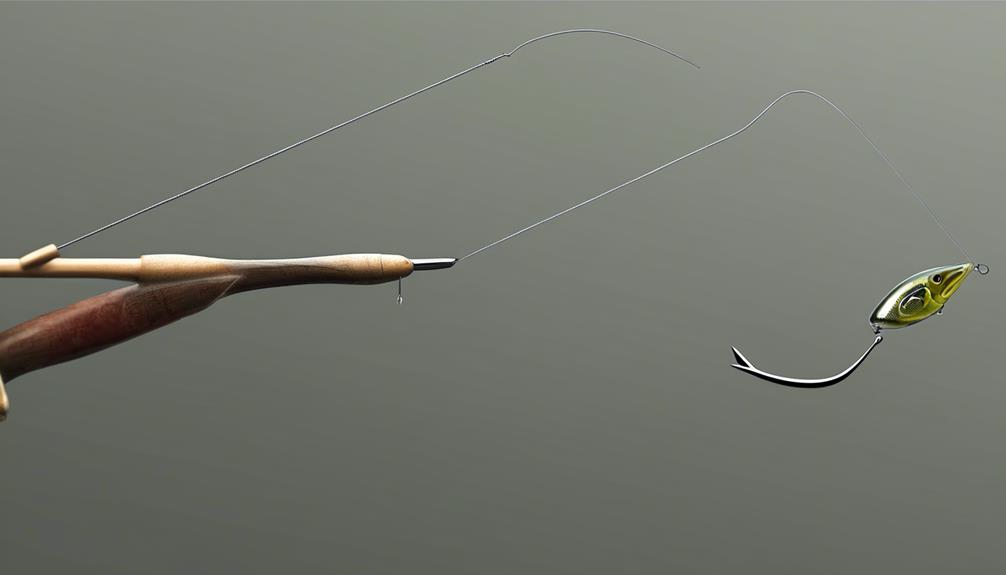
Neglecting to use the appropriate hooks can greatly undermine the effectiveness of your carefully selected line and leader for fishing. Proper bait selection is crucial, but if you're using the wrong hook, you may not be able to effectively present that bait to the fish. Hook shape and size are critical factors that can determine whether you successfully hook a fish or not.
When it comes to hook shape, it's essential to match the hook to the type of bait you're using. For example, if you're using live bait, a hook with a wider gap may be more effective in ensuring a solid hookset. On the other hand, when using artificial lures, a different hook shape might be more suitable for optimal presentation and hooking efficiency.
Moreover, hook size is equally important. Using a hook that's too large can make it difficult for the fish to take the bait properly, resulting in missed opportunities. Conversely, using a hook that's too small may not provide enough holding power to secure a good hookset.
Disregarding Water Clarity
Understanding the water clarity is essential for successful lure usage in fishing. Disregarding water clarity can lead to missed opportunities and unsuccessful fishing trips. Here are a few reasons why you should pay attention to water clarity:
- Understanding fish behavior: Water clarity directly impacts how fish perceive and react to lures. In clear water, fish can see lures from a greater distance, requiring a more natural presentation. On the other hand, in murky water, fish rely more on their other senses, such as smell and vibration, so lures with strong scents or noisy rattles may be more effective.
- Adapting to changing conditions: Water clarity can change due to various factors, including weather, tides, and human activities. It's crucial to adapt your lure choice and presentation to these changing conditions. For example, after heavy rainfall, rivers and streams may become murky, requiring the use of darker or more visible lures to stand out against the turbid water.
- Maximizing success: By considering water clarity, you can maximize your chances of catching fish. By adapting your approach based on the clarity of the water, you can increase the likelihood of enticing fish to bite, even in challenging conditions.
Understanding water clarity and adapting your lure usage accordingly is a key aspect of becoming a successful angler. By paying attention to this often overlooked factor, you can improve your chances of a fruitful fishing experience.
Frequently Asked Questions
How Can I Prevent My Lure From Getting Tangled in the Weeds or Debris in the Water?
To prevent your lure from getting tangled in weeds or debris, try weed-free lure techniques. Choose lures with weed guards or use Texas or Carolina rig setups to keep the lure above the weeds.
Opt for weedless hooks or use a weedless spoon to minimize snags. Also, consider using a heavier line to pull your lure out of the weeds more easily.
These strategies can help you avoid frustrating tangles while fishing.
What Are Some Common Mistakes Anglers Make When It Comes to Adjusting the Retrieval Speed of Their Lure?
When adjusting retrieval speed, it's crucial to match it with the proper lure color for the water and light conditions.
Many anglers make the mistake of using the same retrieval speed all the time, missing out on enticing different fish species.
Varying the speed and experimenting with fishing techniques can help you control the lure action and avoid common mistakes in lure usage.
Are There Any Specific Weather Conditions That Can Have a Significant Impact on the Effectiveness of Certain Types of Lures?
Weather conditions can significantly impact the effectiveness of different types of lures.
Wind can affect casting accuracy and lure movement, while rain can alter water clarity, affecting visibility for the fish.
Additionally, water temperature plays a role in lure performance, as it can affect fish activity levels and feeding patterns.
Understanding how these factors impact lure effectiveness can help you adjust your fishing strategy to maximize your chances of a successful catch.
How Can I Determine the Best Type of Hook to Use for the Specific Type of Fish I Am Targeting?
To determine the best type of hook for the specific fish you're targeting, consider the following factors:
- Fish size: For larger fish, use stronger hooks, while smaller fish may require finer ones.
- Mouth shape: Different fish species have varying mouth shapes, and this can affect the effectiveness of certain hooks.
- Feeding habits: Understanding how the fish feeds can help you choose a hook that will increase your chances of a successful catch.
When selecting a hook, it's important to match the size of the hook to the bait and fish species you're targeting. Using a hook that is too big or too small can reduce your chances of a successful hookset.
Additionally, consider the fishing technique you plan to use. Different fishing techniques, such as live bait fishing, artificial lures, or fly fishing, may require different types of hooks. For example, fly fishing often involves using specialized hooks that are designed for use with flies.
Are There Any Tips for Selecting the Right Leader Material Based on the Type of Water I Will Be Fishing In?
When selecting leader material, consider the water type. For clear water, use fluorocarbon to prevent fish from seeing the line. In murky water, opt for monofilament for better visibility.
Adjust lure retrieval based on water temperature. To prevent weed snags, match the hook size to the fish species. Also, consider how weather impacts lure behavior.
Conclusion
So, next time you head out for a day of fishing, make sure to avoid these common lure usage mistakes.
By choosing the right color and size, using the correct retrieval techniques, paying attention to weather conditions and water clarity, and matching the hatch, you can significantly increase your chances of a successful fishing trip.
Don't overlook the importance of line and leader selection, hooks, and always be mindful of the conditions around you.
Happy fishing!
